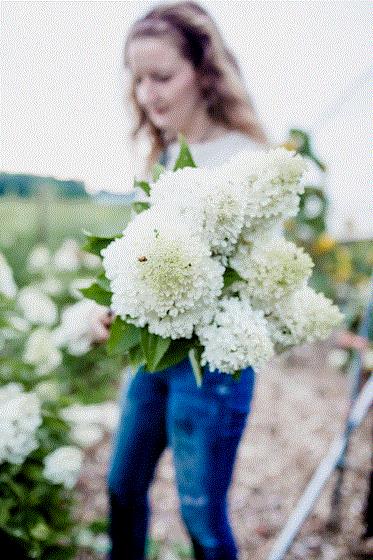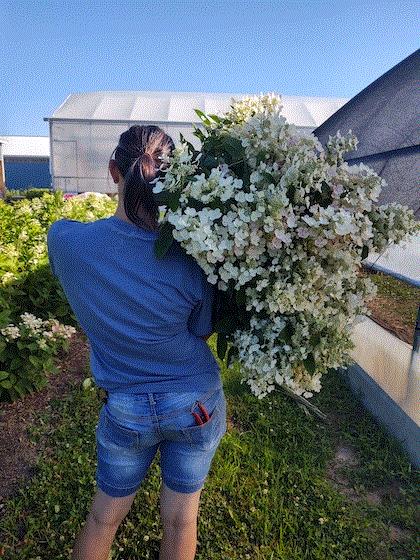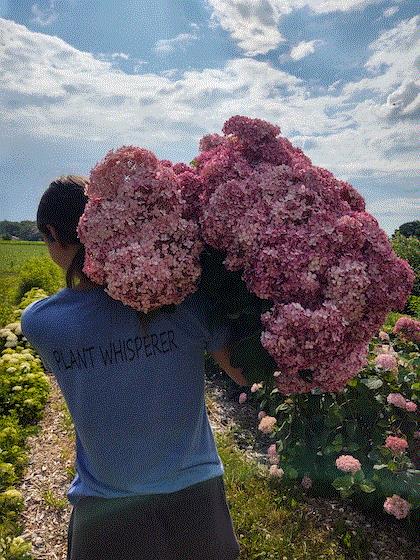"Hydrangeas Speak To the Inner Landscaper In Me"
I have said this before, and I will say it again: invest in perennial crops for your farm!
Once of the first plants Tater and I invested in were hydrangeas. Hydrangeas speak to the inner landscaper in me. I love their bright, prolific, billowy blooms in the middle of summer. Not only do they light up the landscape during the dog days of summer, they are also a profitable showstopper on the farm.
I taught a few ornamental plant identification courses during my time at Michigan State University, and as you can imagine, being able to ID hydrangeas is a key skill as a landscape contractor and flower farmer, since there are so many different kinds. And what kind you have dictates where you should plant them and when you should prune them.
So without further ado, let’s get started in a crash course in cut-flower hydrangeas.
Hydrangea Primer

Tater and I love hydrangeas. Their strong stems and billowy blooms are incredible! Pictured here is ‘Limelight’.
First off let’s talk about Hydrangea macrophylla, or hortensia, or big leaf hydrangeas—they have quite a few names. These guys are ones most florists think of when they buy a hydrangea. They are hardy to Zone 5, and have huge flower heads … if you can get them to flower, that is.
I went crazy planting these guys when I first started farming; I had dreams of massive blue and pink flower heads to cut and sell. Unfortunately, in the last five years, they have yet to give me a harvest. If any of you have good tips or tricks let me know, because we are going to remove them this fall if we don’t get a crop this season!
Unless you are a hydrangea guru, I would recommend planting a more agreeable hydrangea like the ones below. But if you are feeling brave and want to try your hand at the macrophyllas, remember that they flower on old wood. According to the experts at Proven Winners, “flower buds begin to form in late summer and must remain undisturbed all through the fall, winter, spring, in order to flower the following summer.”
Hydrangea macrophylla are truly a sight to behold in full bloom. If you have achieved this level of greatness, Tater and I would love some input and tips to get them to flower in the field.
The folks in Holland who produce them in greenhouses have this down to a science. Check out this VIDEO from Holex Flowers in Holland of a greenhouse full of them. Full disclosure: This is what I was hoping to accomplish in the field—needless to say, I have a lot to learn.

The Paniculatas
Next up are the Hydrangea paniculatas, or the panicled hydrangeas. This is one of my favorite types of hydrangeas because they are an easy grower once established. Panicled hydrangeas can thrive throughout much of the U.S. as they are hardy from Zone 3-8. As long as you give them full sun and well-drained soil, they will yield countless blooms. In northern climates, panicled hydrangeas start flowering mid to late summer depending on the variety.
Unlike the H. macrophylla, which have a round, spherical appearance, the H. paniculatas are more oval and football shaped. The H. paniculata start as either a cream, white, or green. As the flowers age, they darken to either pink or crimson hues. It’s fun to see them transition; we call this process antiquing. Some of our floral designers prefer them as they age, or we can harvest them right away when they flower. The key with the H. Paniculatas is to harvest them when all the florets are open; the unopened florets will likely flag if harvested too early.
The paniculatas are easy to love and easy to keep. But pruning dictates the size, length and quality of your blooms. Unlike the macrophyllas, paniculatas flower on new growth. We prune our hydrangeas late in the fall after the plants are dormant. The size and length of bloom that you want dictates how you prune. The challenge with H. paniculatas as they mature is that the head sizes can be huge, almost too big to use. So part of our job is to make sure we prune them so we get the longest stems and most user-friendly head size. We will go over pruning tips and tricks this fall in a later edition of Bloom Beat. But for now just be aware the H. paniculatas flower on new growth and fall pruning is the way to go. Later in this article we will go over some of Tater’s top hydrangeas picks, and trust me, there are a few paniculatas on her list!

The Smooth Hydrangeas
Hydrangea aborescens, or the smooth hydrangeas, are another great group of hydrangeas for cut flowers. These plants like full sun to part shade. If you plant them in a shadier spot, you are going to get thinner stems, which impacts the quality of your cut flower. We have ours in full sun and they perform well. Stems are strong and the head sizes are exceptional! Like the paniculatas they have a hardiness range of Zones 3-8.
The smooth hydrangeas have a similar shape to the H. macrophyllas; they are spherical, but the florets are smaller and give a much more delicate appearance. The H. arborescens flower on new growth. We also prune these beauties when they are dormant. Colors range from white to green to pinks. In the case of the H. arborescens, you want to harvest them when all the florets are open. But these beauties must be harvested at the appropriate stage, since they do not antique and will expire. Make sure you have them sold ahead of time. Tater and I have a soft spot for the mauve varieties; we will talk more about that later!
The H. arborescens are incredibly prolific, and quite beautiful. The best part is that they require minimal maintenance once established and churn out a lot of blooms per plant. We have a mature stand of Annabelle hydrangeas and we easily harvest twenty stems off each plant every season. Needless to say, they are profitable.
Other types of hydrangeas include: H. serrata (mountain hydrangea). H. quercifolia (oakleaf hydrangea), and H. petiolaris (climbing hydrangea). I have been told that oakleaf hydrangeas make an excellent cut flower. They have the presentation of a panicled hydrangea but they perform well in protected conditions. I’m not sure how well they would perform in an open field, but in the landscape they work well in shade to part shade, so if you have some protected and shadier spots at your farm they would be worth a try. I’m not sure how the mountain and climbing hydrangeas would do as cuts. The climbing hydrangeas would be incredibly short-stemmed but I just want to bring them to your attention so that you know they exist.
Proven Winners has a quick guide to all the different hydrangeas we talked about. HERE is the link.

Tater’s Hydrangea Picks
Tater loves the hydrangea patches on the farm. They are a haven for field mice and rabbits. You can see from this photo that her nose is glued to the ground when we harvest hydrangeas. Tater gets up close and personal with our hydrangeas so she knows a good variety when she sees one. Here are her three top picks for cuts:

Tater enjoys scouting the hydrangeas, especially the ‘Little Lime’ patch.
Little Lime panicle hydrangeas are an awesome cut flower! Their endearing lime-green blooms age to a mottled pink and raspberry color. These are my favorite hydrangeas to watch antique. We actually put some saran over the Little Lime patch to keep the precipitation off of them so they can spend more time on the plant without being damaged. Their smaller bloom size makes them user friendly.

Quick fire hydrangea fresh cut in the field.
Quick Fire hydrangeas are another panicle hydrangea on Tater’s list. These lacy white blooms are a real hit with our designers, especially for wedding work. Their shape and texture are incredibly unique for a hydrangea and are the epitome of a garden vibe. They antique to a nice raspberry color.

Invincible Spirit fresh cut in the field.
Invincible Spirit rounds out Tater’s top three hydrangea picks. I personally love the mauve color, and this arborescens hydrangeas produce a ton of stems once it matures. Remember, the smooth hydrangeas don’t antique, so you must harvest these beauties fresh. But the novel color makes this one an easy sell so you should be able to sell them all. I wish I had at least one more row of these guys!

In Closing
Hopefully, you guys jump on the hydrangea train! Tater and I absolutely adore them. Do you already have some favorite hydrangeas on your farm? What other flower-farming topics do you want to hear about? Tater and I would love to hear from you. Feel free to drop us a line at tater@ballpublishing.com and ldaschner@ballpublishing.com.
Happy Harvesting!
Lindsay Daschner (and Tater)
Editor-at-Large—Bloom Beat
Owner—Forget-Me-Not Farms
This email was received by 4,763 of your fellow fresh-cut flower growers!
If you're interested in advertising in Bloom Beat, contact Kim Brown ASAP and she'll hook you up.